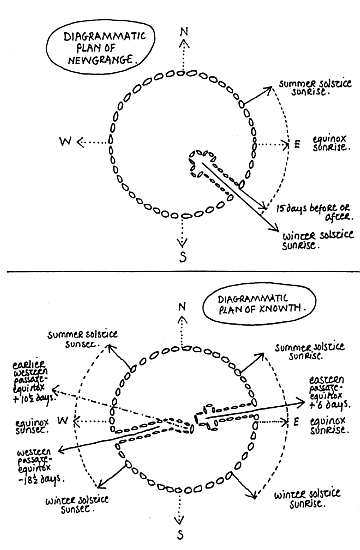
Click the above logo to return to the main site
There is no evidence of permanent occupation of the dwellings or the site as a whole. .. "A completely artificial division has been made in the past between domestic and religious, recreation and ritual ... We're going to have to rethink all that. It's not one thing or the other, it's everything mixed in together."

When I first wrote down my conclusions on the passage mounds – I sent a copy to Professor Eogan, an archaeologist, and another to Professor Wayman, an astronomer. The distinguished archaeologist wrote back saying " I can't comment on your theories because I am not an astronomer". The distinguished astronomer wrote back saying that the numbers looked right but he couldn't comment on them because he was not an archaeologist!

(The) grand temple of Karnak, which is also aligned to the rising sun of the December solstice!
Boreades wrote:The local folklore (that the sun shone into Newgrange on the shortest day of the year) was dismissed for many years by "the experts". What do local people know? Partly because of subsidence of the roofing stones of the passage, it wasn't possible for the sun to illuminate the passage properly, until 1967 when conservation work repaired the passage. And lo! The sun now shines down the passage exactly as the ignorant locals described.
Folk memory and oral traditions are often rubbished by the "experts", and written histories based on oral traditions are often dismissed as forgeries, even by world-famous revisionist historians! ;-)

Following a visit to Ireland in 1769, one of the earliest antiquarian accounts of Newgrange, a letter of Pownall’s entitled "A Description of the Sepulchral Monument at New Grange, near Drogheda, in the County of Meath, in Ireland. By Thomas Pownall, Esq in a Letter to the Rev. Gregory Sharpe, D. D. Master of the Temple" was read to the Society of Antiquaries in 1770 and subsequently published in Archaeologia. Earlier descriptions of the monument had been published by Lhwyd and Molineux but Pownall commissioned Samuel Bovie, a local land-surveyor, to re-measure the mound, correcting Molineux’s mistaken estimate of the height as 150 feet.
Users browsing this forum: No registered users and 21 guests